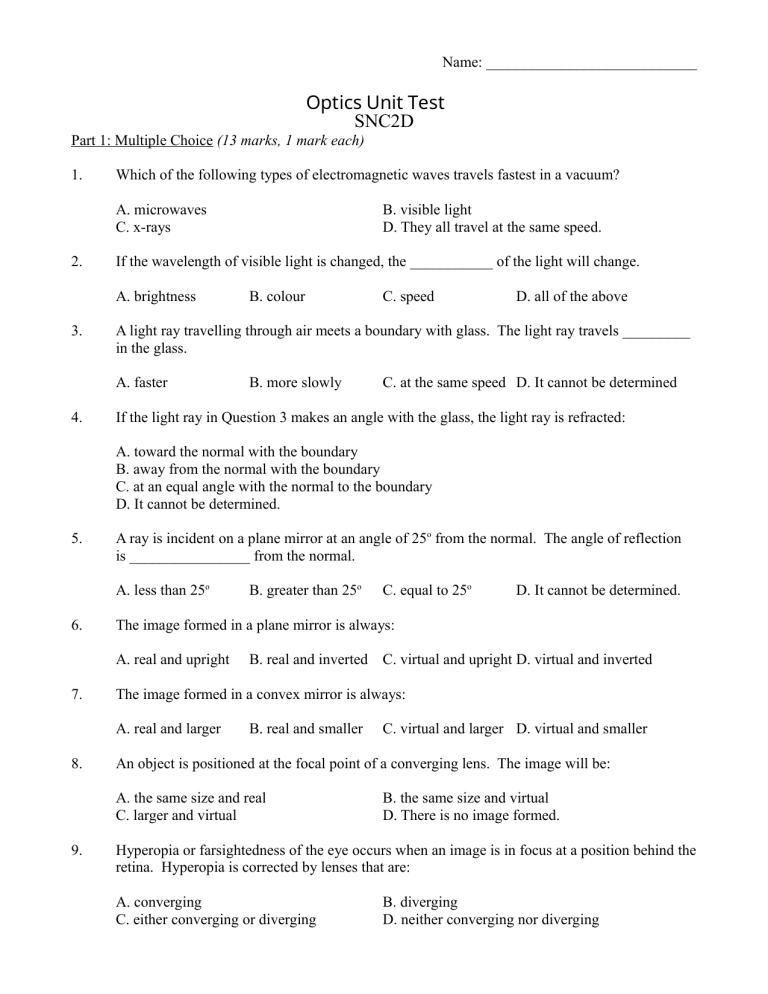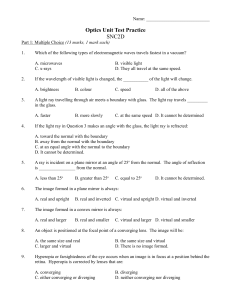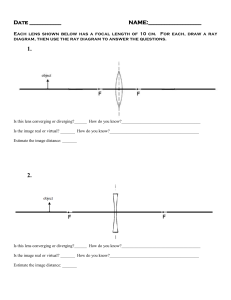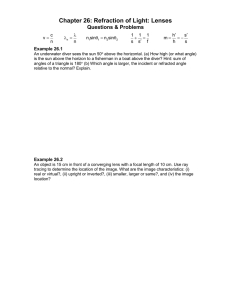
Name: ____________________________ Optics Unit Test SNC2D Part 1: Multiple Choice (13 marks, 1 mark each) 1. Which of the following types of electromagnetic waves travels fastest in a vacuum? A. microwaves C. x-rays 2. If the wavelength of visible light is changed, the ___________ of the light will change. A. brightness 3. B. colour C. speed D. all of the above A light ray travelling through air meets a boundary with glass. The light ray travels _________ in the glass. A. faster 4. B. visible light D. They all travel at the same speed. B. more slowly C. at the same speed D. It cannot be determined If the light ray in Question 3 makes an angle with the glass, the light ray is refracted: A. toward the normal with the boundary B. away from the normal with the boundary C. at an equal angle with the normal to the boundary D. It cannot be determined. 5. A ray is incident on a plane mirror at an angle of 25o from the normal. The angle of reflection is ________________ from the normal. A. less than 25o 6. B. real and inverted C. virtual and upright D. virtual and inverted B. real and smaller C. virtual and larger D. virtual and smaller An object is positioned at the focal point of a converging lens. The image will be: A. the same size and real C. larger and virtual 9. D. It cannot be determined. The image formed in a convex mirror is always: A. real and larger 8. C. equal to 25o The image formed in a plane mirror is always: A. real and upright 7. B. greater than 25o B. the same size and virtual D. There is no image formed. Hyperopia or farsightedness of the eye occurs when an image is in focus at a position behind the retina. Hyperopia is corrected by lenses that are: A. converging C. either converging or diverging B. diverging D. neither converging nor diverging 10. Most of the refraction of the eye occurs in the: A. cornea 11. D. retina B. colourless C. opaque D. white C. refracted D. all of the above Dispersion can occur when white light is: A. absorbed 13. C. pupil An object that reflects all colours of light will appear: A. black 12. B. crystalline lens B. reflected Light produced by an object at a high temperature is called: A. chemiluminescent B. fluorescent B. incandescent D. triboluminescent Part 2: Short Answer and Diagrams (4 marks each) 1. Sketch what happens when light rays parallel to the principal axis strike a (a) plate glass window; (b) converging lens; (c) diverging lens. Which can form a real image? 2. Sketch the eye and label the cornea, crystalline lens, retina, and iris. 3. An object is placed 6.0 cm from a converging lens with a focal length of 2.0 cm. Sketch a ray diagram to locate the image and describe the characteristics of the image. Part 3: GUSS Solutions (5 marks each) 1. (a) What is the frequency of a light ray of wavelength 650 x 10-9 m? (2 marks) (b) If the ray is incident on a transparent surface at an angle of 36o and the angle of refraction within the material is 25o, find the refractive index of the material. (3 marks) 2. An object of height 3.0 cm is placed 8.0 cm from a converging lens of focal length 6.0 cm. Find (a) the location and (b) the height of the image.(5 marks)



